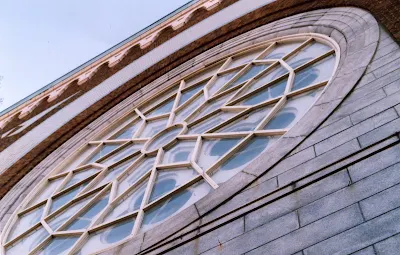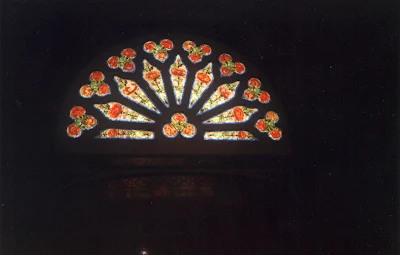Friday, January 30, 2009
My Drive Home From Work (four)
Tuesday, January 27, 2009
My Drive Home From Work (three)

Friday, January 23, 2009
My Drive Home From Work (two)

Sunday, January 18, 2009
My Drive Home From Work (one)




From the top down: passing where the toll booths used to be after you've crossed the Champlain Bridge; slowing to rubber neck an accident...looks like she rear-ended him...; then the twin spires of a church in St. Henry (just at the top of Georges Etienne Cartier park on rue Notre Dame); then approaching the exit for Sherbrooke West and hang a left at the lights at the top before passing Girouard and memories of the past... This was maybe September 2007.
Friday, January 16, 2009
A few notes on Confessional Poetry
Thursday, January 15, 2009
Wednesday, January 14, 2009
"Scribble down your nakedness." -- Allen Ginsberg
Scribble Down your nakedness, said Ginsberg -- and he did
By Peggy Polk
New York
Conrad Rooks, the rich boy who went from beatnik to alcoholic to drug addict to moviemaker, is going even further soon -- to the Indian province of Dharmasala, home of the exiled Dalai Lama.
His first film "Chappaqua," winner of the Silver Lion at the 1966 Venice film festival, opened at a New york theatre Sunday and is scheduled to make the rounds of art movie houses throughout the country, but Rooks is preparing to retire to the study and filming of Tibetan metaphysics.
"Chappaqua" -- named for the Indian burial place -- is a full color, baroque nightmare based on the cure which its 32-year-old author -- director-producer-principal player took in Zurich six years ago to rid himself of his addictions.
The Kansas-born Rooks traces his taste for narcotics to a series of operations he underwent at the age of 9. He says he began drinking when at 13 he started to frequent bars on New York's West 52nd Street to listen to jazz and at 14 he was an alcoholic.
Expelled from four prep schools, given a medical discharge from the Marines and arrested at 21 on a marijuana charge, he tried to learn the craft of writing from his beatnik friends. But it was not until his father died in 1961 that Rooks decided to take the 30-day "sleep cure" he was to tranbscribe to the screen in a rich melange of sound, color and stunning technique.
To make the film, Rooks assembled the patron saints of the beat and hippie world -- poet Allen Ginsberg, writer William Burroughs of "Naked Lunch" fame, French actor Jean-Louis Barrault, Moondog and Swami Satchidananda. Ornette Coleman played the saxophone and Ravi Shakar the sitar. Robert Frank, the avant garde photographer, was camerman.
The movie, from its inception as a poem, took four years and $750,000 of Rook's Avon Cosmetics fortune to film. It was one of the few such personal ventures to emerge from the underground to commercial distribution.
Rooks, who sports a Buster Brown haircut and a didactic manner, says he is delighted with the venture but has no intention of joining the filmmmaking establishment.
Business, he says, is corrupting and "businessmen have pretty much managed to run commercial moviemaking into a baloney factory.
"Of course I want to reach mass media. But I want to change mass media."
Hoping to avoid the baloney business entirely and to continue the process of self-education he began in the 1950s at the "baby end of the beat generation," Rooks, who has been married and divorced, says he will leave for northern India before Christmas with his young son, his girl friend and his crew.
There, he says, he will experiment with "pure film" under the aegis of the Dalai Lama. "He's interested in me," the movie maker said. "I've already spent some time with him in India. My guru took me. He wants me to come back; he is interested in my ideas of film."
One of those ideas is that filming should proceed like writing. A writer may experiment by constructing a paragraph a dozen ways. A film maker should do the same, Rooks says, by taking a variety of shots and putting them together in a variety of ways.
"Film isn't expensive," he says. The most you can spend if you shoot all day is $100,000.
Rooks is also convinced that the movie maker has no business trying to reproduce a novel on film. He must originate his own material.
"Chappaqua," he says, is a result of advice Ginsberg once gave him:
"Scribble down your nakedness. Be prepared to stand naked because most often it is this nakedness of the soul that the reader finds most interesting."
"Chappaqua" is autobiographical in the same way that Burroughs' "Naked Lunch," Ginsberg's "Howl" and Jack Kerouac's "On the Road" are autobiographical, Rooks says.
But in his next film, Rooks wants to go outside of himself and "through some sort of simplicity, reveal some of the teaching which Asia is about to let us learn.
"We are basically uncultured races that are now coming into contact with the vastly more subtle races of the east and their cutlural knowledge is beginning to conquer us," he says. "Look at the Beatles running after their guru. Look at Mia Farrow going to India for spiritual teaching.
Working with the Tibetan exiles also has its practical advantages.
"There are 90,000 refugees all willing to do this kind of labor," Rooks said. "There are 20,000 artists doing nothing but sitting in front of tents now waiting for the Indian government to feed them. We'll put them to work."
Monday, January 12, 2009
Sunday, January 11, 2009
Be Strong: Fight For Your Vision
You have to fight for this life, fight for your vision. Fight to stay alive and creative and breathing, filling your two lungs to capacity and then letting the air out in giant breaths of poetry; breathe in that life is good, life is good, life is good. Be grateful for each breath and feel life moving through your body; breathe out the great breaths of poetry, speak love, speak the words of your vision that keep you alive, and in all things it’s a fight for your vision, your voice, your love for this life.
Tuesday, January 6, 2009
John V. Morrissy and the self-named Morrissy Bridge in Miramichi, NB
 John V. Morrissy, a former cabinet minister in the New Brunswick government, and later a Member of Parliament in Ottawa, can be seen in this photograph (seated, middle of three in first row, handle-bar moustache). Later, John Veriker Morrissy was a Member of Parliament (for the Liberal Party of Canada) in Ottawa. His son, Charles J. Morrissy, followed him in a political career, and also served as an M.P. in Ottawa.
John V. Morrissy, a former cabinet minister in the New Brunswick government, and later a Member of Parliament in Ottawa, can be seen in this photograph (seated, middle of three in first row, handle-bar moustache). Later, John Veriker Morrissy was a Member of Parliament (for the Liberal Party of Canada) in Ottawa. His son, Charles J. Morrissy, followed him in a political career, and also served as an M.P. in Ottawa.
The Morrissy Bridge, that John V. Morrissy named after himself, across the Miramichi River joining Newcastle with Chatham, NB. We always heard about family (especially Dr. Herb Morrissy) living in Newcastle. The bridge was built, prefabricated, in Lachine, Quebec, not far from where I live, and later installed in Newcastle.
































